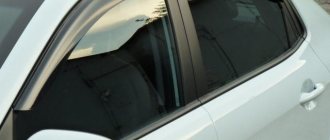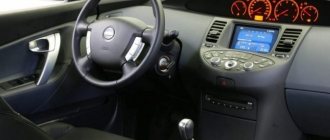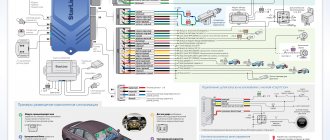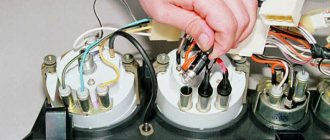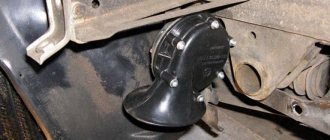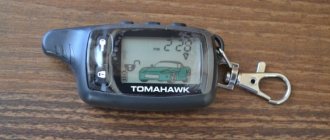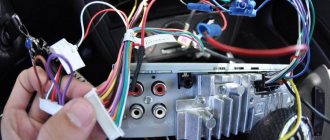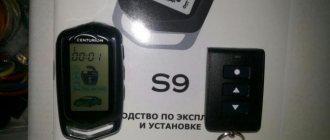02/26/2022 1,948 Alarms
Author: Victor
The sequence of connecting the central lock to the alarm depends on its type: pneumatic, with constant or variable polarity. However, in order to correctly connect the central locking system using any of these schemes, you first need to prepare a lamp probe. To search for circuits on cars of recent years, it is better to use a voltmeter so as not to damage the wiring.
[Hide]
Central locking device
A central lock is a complex of units with an electromechanical drive.
The central lock includes the following components:
- Control block;
- input sensors and buttons;
- actuators (activators).
Central locking components
The trunk lid and fuel filler flap can also be equipped with locking devices connected to the central locking system.
Control block
The control unit monitors the position of limit switches, control buttons, as well as contact groups of door locks and other sensors that are connected to the unit by wires.
Initially, the electronic part of the unit was contained in one housing with connectors. However, new car models also use CAN buses, with which you can divide the central locking control system into separate elements. This allows you to install them in different places on the body.
Example of a central locking control unit
Additionally, the BU may include:
- Sending a signal to the turn signals, which flash briefly when locked/unlocked. With this option, the alarm can be connected to the appropriate wires and the turn lights will be activated.
- Receiver of signals from the remote control. If this receiving device is located outside the unit, then the connecting wires can also be used to control the car alarm.
If the central locking system has a multifunctional complex control unit, then most of the wires of the installed security system are connected to its connectors. A siren, alarm sensors, and, if available, an engine blocking device will require separate connections.
Input sensors and buttons
The central locking system includes several groups of input sensors used in alarm installation:
These include:
- “Limit switches” are limit sensors of car doors that determine their closed or open position. The supply of light to the corresponding lights in the cabin depends on their signals.
- Door lock microswitches. They signal the closed/open state of the car door lock.
- Microswitches in the electric lock drive. They send signals about the status of door locking devices - locked/unlocked.
The control button in the cabin can be one on the driver's door or on the panel, or two on both front doors. The central locking is usually controlled using a two-way button with three contacts - one common and two normally open. There are also two- or five-pin keys.
Actuators
There are electromechanical drives and pneumatic drives for central locking actuators (activators).
In the design of central locks of modern cars, pneumatics are no longer used; electric drives are used everywhere.
Electric drive
There are several different types of electric drives with a traction force of 2.5 - 6 kg. The most common types are square and T-shaped (“pistol”).
The electric drive mechanism is housed in a plastic case. Structurally, it consists of an electric motor and a metal (or plastic) gearbox. When the polarity of the voltage supplied to the electric motor changes, the shaft rotates either clockwise or counterclockwise. Torque is transmitted to the gearbox, which converts rotational motion into linear motion. The direction of rotation determines whether the door lock is locked or unlocked.
The drives are controlled by short-term pulse voltage - lasting from 0.8 to 1.5 seconds. This is enough to trigger the lock mechanism to open or close. If the voltage supply time is made longer, the electric motors will fail.
Electric door lock circuit diagram
Among electric drives there are options with two electric motors. One is used to close/open the lock, the second blocks the mechanical drive of the locking device, preventing it from being opened from inside the car using a handle or rod. Such electric drives are controlled by three wires.
Electric motors differ in the presence or absence of a contact microswitch mechanically connected to the retractable rod. Two motor wires complemented by three switch cables form a five-wire electric drive.
They are usually installed in the front doors of the car, and a microswitch transmits signals to the two-wire motors found in the rear door locks. The corresponding commands (to close or open) are sent when the front doors are locked or unlocked with the key or when the control button is pressed.
Photo gallery: types of electric drives
Electric door opening/closing drive
Electric trunk opening/closing
Pneumatic drive
The main design element of the pneumatic actuator is a rubberized membrane with a rod, placed in a plastic housing, which contains a fitting for air supply. Under pressure, the membrane rises, and under vacuum it lowers, moving the rod and locking or unlocking the lock.
Some pneumatic devices, like electric drives, are equipped with a contact microswitch. It is connected mechanically to the rod and works on the same principle as in electromechanics.
Some types of pneumatic actuators have electromagnets with a movable core (solenoids). They serve as additional protection and prevent unauthorized attempts to open the lock. If an effort is made to lift the rod without an enabling command from the control unit, the microswitch is activated and voltage is applied to the solenoid. The electromagnet core blocks the rod, at the same time a command is sent to the compressor to create a locking vacuum of air.
First stage
Removing door panels.
First you need to remove the door trim and dust curtains from each door. Before doing this, you should disconnect the terminals from the battery for your own safety.
Removing the door panels is a fairly simple task - unscrew the 4 screws under the shelf. Now you need to remove the handle. Then you can carefully remove the upholstery. Think about the three latches located on the edge of the lock. The door has a plastic screw that needs to be unscrewed. Then remove the screws located in the trim under the steering wheel (the first on the left and the other on the right side).
Selecting a location for installation.
To choose a suitable location for the central locking for installation, you need to take into account the location of the insides of the window regulators. It is possible that you will need to make a separate bracket for mounting
Experienced craftsmen suggest that the lower left corner is the best place for installation, because when lowering the glass, the latter will not touch the lock and interfere with its operation.
Installation of the activator.
Lock activators are installed separately on each door. To do this, you need to drill additional holes and secure them with self-tapping screws. We do the same installation for each door.
Attaching the activator to the lock rod.
Each activator from the installation kit must be secured to the door with clamps. Very often, the central lock has a large force that the activator must apply to open the door. Since the stroke of the actuator rod is greater than that of the lock rod, it is necessary to align the center of the stroke of both rods.
Further from the activators, we install clamps on the rods of the manual lock block. This work must be done with each individual car door. When connecting actuators, you need to check the wiring for current conductivity.
If the hole in the central locking rod is larger than necessary, you can use a plastic bushing that will reduce its size to the required size.
Pulling wires.
The four wires that go from each activator (two to it, and two to the car body) can be attached using plastic clamps. This work is performed individually for each individual vehicle. You can use existing holes or drill your own. It is not recommended to lay wires at the bottom of the door, where moisture most often accumulates.
In the problem area of the gasket - the opening between the body and the car door - it is better to use a rubber tube through it, which will protect the wiring from kinks and chafing.
The video shows the installation of central locking on a car:
Operating principle of central locking
Locking and unlocking of car doors and other body elements is carried out by turning the key in one of the door locks or by pressing a button installed in the passenger compartment. Control signals are sent to the electronic unit, which issues commands to the drives to lock or unlock the doors, trunk and gas tank hatch.
Signals are transmitted by wire or contactless - when an impulse is sent from the remote control to the antenna and then to the control unit.
The central locking system also provides a function for automatically unlocking all locks if the vehicle is involved in an accident.
Causes of activator failures
The central lock (VAZ-2110) has the following components in its design:
- Semiconductor control unit for electric drives.
- The actuators are geared motors (4 in total - one for each lock, but if there is a drive to unlock the trunk, then five). These are small electric motors with gearboxes on the rotors.
- allowing you to determine the condition of the lock (installed in the gearmotor mounted in the driver's door).
- Wires, connections, fuse.
The VAZ-2110 central lock can operate in several modes:
- All locks are activated when the driver's door is unlocked/locked.
- When arming and disarming a car alarm. Provided that the alarm and central locking control units have been connected.
- If there is a function for remote control of the central locking from the key fob. Such control systems have a fairly low cost and can be used on cars without an alarm system.
It is with their help that the VAZ-2110 central lock is controlled. They are mounted in the doors and have a plastic body. Incidents of meltdown are rare, but they do happen. Especially if the device is subject to a large load or the motor is frequently triggered. In case of a physical defect (melting, destruction), the following symptoms appear:
- On the door in which the defective activator is located, the unlocking/locking function stops working.
- The fuse fails due to excessive loads on the supply circuit.
The next important element of the entire system is electrical wiring. The operation of the central lock depends on its condition. If there are abrasions on the wires or cuts, this will inevitably lead to either spontaneous activation of the activators or to their inoperability. Most often, the wiring is destroyed at the bends - between the door and the body.
How to connect the alarm to the central locking system yourself?
To independently connect the central locking to the alarm system you need:
- experience working with auto electricians;
- set of tools;
- connection diagram (detailed instructions) taking into account the type of central locking installed on the car.
Preparing tools
The required set of tools for self-installation of an alarm system on a car should consist of:
- a set of Phillips and flat blade screwdrivers;
- wire cutters or scissors for cutting cables;
- set of wrenches;
- pliers or terminal crimping tool;
- knife or wire stripper;
- drill or screwdriver with a set of drills;
- soldering iron;
- network voltage meter;
- insulating tape.
Connection diagrams
The circuits under consideration are intended for car alarms equipped with built-in relays for controlling locks - they have three wires each for locking and unlocking.
The universal connection option looks like this.
Connection diagram of the alarm system to the central locking
Central locking is controlled by constant polarity
The alarm wires connected to the central locking can be power or signal. For power outputs use the following circuit:
The white cable connected to the alarm connector provides a signal for unlocking (UNLOCK), and the green cable provides a signal for locking (LOCK). The relay indicated in the diagram above is responsible for locking. Normally open contacts must be connected to the “minus”; common contacts must be connected to the signal wires of the central locking system.
During installation, please note that the wiring from the connectors of the electronic central locking unit is not cut off - both alarm cables (white and green) are simply connected to it. The security system wires do not have to be connected to the relay connectors; you can connect them to low-current signal terminals.
If the central locking system uses not negative, but combined polarity, then diodes should be installed when connecting (the arrow on them should be directed towards the alarm connector).
To connect to the central locking system with constant positive polarity, the same circuit is used, but with minor differences.
Normally open contacts in this type of central lock are connected to the positive pole, but not to ground. In the diagram, the upper relay gives the command to lock, the lower relay gives the command to unlock. In this option, instead of relay contacts, you can also consider using signal pins, but when installing diodes, the arrow should be directed in the opposite direction - to the central locking connectors.
Central locking controlled by variable polarity
When controlling central locking with variable polarity, the alarm is connected directly to the power wires.
Use a probe to determine the required cables:
- One contact is placed to the positive pole, and the other is looking for a wire, upon contact with which the light bulb of the device lights up. When a command to open or close is sent to the central lock, the probe lamp goes out.
- Then the first probe of the probe is moved from “plus” to “minus” and again sends a signal to the central locking. The device lamp should light up when opening or closing.
When two power wires that control the door lock actuators are found, you need to cut them to connect the alarm.
If the “signaling” has low-current positive/negative outputs, two additional relays are used when connecting
After this, you need to make a connection according to the following diagram:
- NO contacts are connected to the positive wire;
- NC contacts – to cables going to the electronic unit or to the central locking control button;
- O-contacts are connected to control wires going to the door lock drives;
- The alarm output cables are connected to the relay coils on either side.
The second side of the relay is connected depending on the polarity of the car alarm output:
- positive output – to “minus”;
- negative – to “plus”.
Central locking with pneumatics
In pneumatic (vacuum) versions of central locking control, instead of two wires, signals are transmitted one at a time. You can find the control cable in the luggage compartment near the compressor or under the rear seat. When the locks are unlocked, it will have a positive charge, and when locked, it will have a negative charge.
Alarm connection diagram:
The required cable is determined by a probe - one probe of the device is set to “minus”, the other one checks the wiring, closing and opening the central lock. When unlocked, a positive charge is recorded on the control wire, and the device lamp lights up. Then the probe probe is moved to the “plus”, and the other is held on the same wire and when locked, a “minus” should appear.
The found cable is carefully cut and connected to the alarm contacts. To avoid confusion and damage to the electronics, you can apply first a positive, then a negative charge through the probe to the end going to the compressor. If everything is correct, the door locks will open and then close.
If the alarm system being installed has built-in power relays, then the connection is made as follows:
- at the unlocking relay, the NR contact is connected to the “plus”;
- NC contact - into a break in the wire directed to the central locking control button;
- O-contact – to the NC-contact of the locking relay;
- at the locking relay, the NR contact is connected to the “minus”;
- O-contact - into the break in the wire directed to the compressor.
Blocking via CAN bus
An engine blocking relay is the simplest and most common way to prevent unauthorized engine starting. Regardless of whether the relay is built into the central alarm unit itself or an external one is installed, the essence of its operation is the same. As long as no current flows in its winding (cars use relays with low-current windings, so they can be directly connected to the alarm output channels), the relay armature (common contact, 30) is electrically connected to a normally closed contact (NC, 88 or 87a).
it will remain closed forever.2. When blocked by a normally open contact, every time you turn on the ignition on a disarmed car, the contacts close, opening when the ignition is turned off. The relay wears out, but when the central alarm unit is turned off, the protected circuit will remain open.
Which circuits can be reliably protected using relay interlocking? The most useless thing is the starter interlock relay, because on many cars the starter is turned on forcibly by closing the contacts of the retractor relay under the hood with a screwdriver or key. In addition, such a lock is useless during a robbery: by taking away your already running car, the robber can safely drive away.
It will also not allow you to start the engine, but if you have access to the engine compartment, it will do the same, using a temporary wire. Without a reliable additional hood lock, such a lock will not stop the thief for long.
The resistance of resistor R1 must be equal to the resistance of the crankshaft position sensor winding. In this case, when the blocking relay is triggered, a “trick” is connected to the inputs of the injection ECU, and instead of recording the error, the ECU will not “see” the rotation of the crankshaft.
The blocking relay switching diagrams indicate a diode connected in parallel with the winding. In some relays it is even built in from the start. What is it for? The fact is that the relay winding has a certain inductance, and when the power is turned off, a sharp surge of voltage occurs in it with the polarity reversed to the original one.
However, on modern cars there is an even more elegant way to block the engine from starting. In this case, there are no physically broken circuits, and there are no additional connections: it is enough for the alarm to have a connection with the car’s CAN bus.
The essence of such blocking is that when an alarm is triggered, the alarm transmits a blocking command via the bus and repeats it all the time until the alarm goes off. And until the thief turns off the central unit, attempts to start the engine will be useless. If we take into account that with proper installation of the central unit, half of the interior will need to be disassembled to remove it, then this method is clearly the leader in terms of efficiency.
Recommendations and possible difficulties
Independently connecting the central lock to the alarm system has the following difficulties:
- If you do not have the skills to work with the electrical circuits of a car, it is easy to make an error in the installation, which can lead to a short circuit, failure of the central locking elements and the alarm system.
- Access to some parts of the central locking system and additional equipment may be difficult.
Recommendations:
- For self-installation, simple security systems with a minimum set of sensors are more suitable.
- To connect complex car alarms (with a GSM module, starting turbocharged engines, car heaters, etc.), it is better to contact specialists.
- When installing an alarm system, it is advisable to avoid interfering with the central locking control units. Soldering into them should only be done as a last resort, making do, if possible, with installing relays, diodes and other elements. You can use special modules that allow you to connect and configure the security system via CAN buses.
Control block
This component determines how the remote controlled central locking will operate. For most cars, its circuit is made using digital elements. They are designed to process incoming signals according to a preset algorithm. The approach under consideration allows manufacturers to achieve the highest quality connection between the central locking, alarm and remote control.
In most cases, the systems mentioned above are installed by the car owner. Manufacturers install security systems and remote control systems in modern car models. For effective control, the circuit provides for the presence of an additional electronic unit. With its help, the driver has the ability to control the central locking using a special remote key fob. The signal transmission range depends on the selected device model.
Checking for correct installation
To check the installation is correct, perform the following steps:
- They connect the battery and give a command from the remote control to lock the central locking. To be on the safe side, leave one of the door windows open. This will allow you to open the car manually if for some reason the unlock command does not work.
- After locking the central locking system, a command is given from the remote control to unlock it.
- After correct execution of the commands, the wire connections are insulated with heat-shrinkable tubing or electrical tape.
If at any stage of the test the system does not receive a signal and operate, you should once again check that the wires are connected correctly. If they are connected correctly, there may be damage somewhere.
It takes two people to determine the malfunction - one will send signals from the remote control to lock and unlock the central locking system. At this time, another, using a tester, will check the voltage at the power outputs of the security system and at the fuse contacts. You also need to check the voltage at the contacts of the central locking button.
Video rules for checking the alarm connection
Filmed by the AUTOSECURITY channel - Anti-theft Studio.
Starline does not open or close doors using the key fob: main problems and solutions
The Starline alarm system is a reliable system that protects the car from theft, but at the same time, problems may arise with opening the doors using the key fob. They may be due to a simple decrease in battery charge or incorrect signal recognition by the system. But in some cases the situation is more serious and there are several ways to solve the problem.
Problem with opening doors after autostart
After using the autostart function, the Starline alarm system can block the automatic opening of doors even if the system is disarmed. In this situation, you have to use the key and open the car manually.
The problem may be caused by incorrect connection to the central locking control circuits during installation. To solve, it is necessary to reconnect 2 alarm wires responsible for controlling the lock, provided that there are no problems with the circuits responsible for the operation of the seat belt.
If the seat belt cover in the driver's seat is closed, the doors will not open.
It is also necessary to take into account the indicators on the key fob - unlocked/closed lock. This indication indicates arming or disarming, but not unlocking or locking the door.
None of the alarm systems, including Starline, have the ability to control the process of opening and closing the central lock and simultaneously display the operation on the lock screen.
Problems with locking the car with the key fob
The Starline alarm system may have problems locking the car. At the same time, the warning system operates normally, but the doors remain open. The reason may be a simple disconnection of the plug under the driver's seat.
Therefore, the alarm system cannot recognize the signal from the limit switch about the door opening, which entails the automatic installation of the car in the security mode within 30 seconds. The fuses on the contacts in the alarm unit may also be damaged, preventing the signal from being sent.
Diagnosis and solution to this problem can be achieved in the following ways:
- Without removing the key from the ignition switch, you must open the driver's door and then remove the key. Then slam the door and put it in security mode.
- Disconnect and reconnect the negative terminal from the battery.
- Pull the handbrake, remove the key, open the driver's door, press the central locking button to close all other doors, close the driver's door and press the lock button on the key fob.
If after these manipulations the problem is not solved, then you need to contact the Starline service center for advice and a possible replacement of the system during warranty service.
Which is better: alarm or central locking?
The central lock has low anti-theft capabilities compared to the alarm system. An attacker can break the glass without much effort and relatively easily steal a car without a key by closing the ignition contacts.
Compared to a standard central locking system, a car alarm provides additional degrees of protection:
- The fact that an alarm system is installed, as indicated by a flashing LED beacon in the cabin, reduces the risk of burglary.
- Sound and light signals given when an unauthorized entry into the car is attempted attract attention and deter burglars.
- Modern security systems have an engine blocking option (immobilizer). Even if someone breaks into the car and turns off the siren, it will be impossible to steal the car.
- Many alarms provide the car owner with information about the condition of the car, which is displayed using a feedback system on the key fob display. When attempting to break in, an alarm and a danger message will be sent to the remote control.
Installing a modern car alarm also makes car operation more comfortable. For example, you can use it to configure remote engine start or turn on the preheater.
FakeHeader
Comments 31
Hello. Can you please tell me how and where to connect the power window closers?
the green wire is responsible for the impulse for the power window module
Why is it necessary to install a relay on the trunk? Why can’t you put a plus from the battery and a minus from the block onto the activator?
because there is a low-current control on the block, it will just burn out, that’s all, so that it doesn’t burn out, they put a relay
Damn, I read the first comments and my brain exploded, but if you understand the essence like this, then neither the alarm nor the immo or anything else will save the car from real thieves. Why all this controversy? Central locking is a really convenient thing, it won’t affect safety in any way, an experienced thief will open your trough in a couple of minutes, but an inexperienced one will stupidly take out the glass and steal what he can, so now put bars on the windows? The original system can also glitch, but the signaling system was correctly noted, this is not so much protection as a way of attracting attention, not effective as practice shows, because everyone is sick of empty alarms and no one reacts anymore. By the way, a fun fact: for about 3 years now, if not more, I haven’t heard a single car screaming in the yard at night. The time has probably passed when it was fashionable and the car was screaming every leaf that fell on it.
what's the use of it? it doesn’t guard, it’s probably broken by a code grabber. a waste of money
How can you not understand that this is from the budget segment, for people who lock their car with a key and there has never been any security there and never will be, and they don’t give a damn about whether it is protected there or not, they are just tired of poking around with the key. that's what it's for
and it is not yet known when it will glitch or burn the locks, because only God and the Chinese know who wrote the software for it and how
No matter how crookedly it was written there, it will be more reliable than the electrician Vasya, who will write the software. The Chinese are leaders in this area. Tell me what is not China now?)
I beg you, you apparently haven’t worked with such equipment, I have, it would be better if our programmers wrote it. You don’t know how Chinese programmers work? Like bad doctors, they treat one thing and cripple another, they corrected 1 mistake, introduced 3 new ones. This applies even to large factories, everyone is guilty of this.
There is a good product. There is a cheap one in which everything speaks for itself, like here. for 500 rub. There are other blocks for 9 thousand. Can you feel the difference? The quality is also felt. I can’t say anything about the Chinese doctors, my father attended a couple of sessions, and it helped him a lot, he visited our doctors, and he was no longer alive.
They can ruin even a good product, it’s been verified. For 9 thousand there is already an alarm system with auto start, nothing like a simple central locking system. I was not talking about Chinese doctors, but about crappy doctors. At least read the text carefully. The fact that my father passed away after visiting our doctors does not necessarily mean that the doctors are to blame; the reason could be the incurability of the disease, such as CANCER, for example.
Don't be funny ok? My neighbor died because the doctors made an incorrect diagnosis. Afterwards, treatment with various medications was prescribed, which in turn brought him to the next world.
How much does it cost to connect?
Prices for installing alarms in car services vary depending on:
- region;
- the complexity of the security complex itself;
- qualifications of service personnel;
- vehicle models.
Table: cost of alarm connection
The table shows the minimum prices for alarm connection in different regions.
| Region | Price | Firm |
| Moscow | from 1,000 rub. | "Car service on Mosfilmovskaya" |
| Chelyabinsk | from 2000 rub. | "MM auto" |
| Krasnoyarsk | from 1500 rub. | "Avto-r" |
| Ekaterinburg | from 2,000 rub. | "Motor1ru" |
| Krasnodar | from 2,500 rub. | «Europe-Car | Tuning-South. RF" |
Video: rules for connecting a car alarm to the central locking
Filmed by adekWatt channel.
Do you have any questions? Specialists and readers of the AUTODVIG website will help you ask a question
Was this article helpful?
Thank you for your opinion!
The article was useful. Please share the information with your friends.
Yes (80.00%)
No (20.00%)
X
Please write what is wrong and leave recommendations on the article
Cancel reply
Rate this article: ( 5 votes, average: 4.80 out of 5)
Discuss the article:
Repair
In fact, the central lock tends to break not only due to frost. Activators often become unusable.
Activators are one of the important parts of the entire system. In addition to the fact that activators are performers, the driver's door activator is also a sensor. The fact is that the activator on the driver’s side sends a signal to the control unit when it is pressed and closes everything. There are often systems where, in order to lock everything, you need to press the driver's door lock button. This button is screwed to the activator. Based on this, the driver's door activator causes all activators to operate. Here you will need to disassemble the door and see if the button on the activator is pressed; if not, then raise the activator higher, and if the button is pressed but nothing happens, you need to change it.

